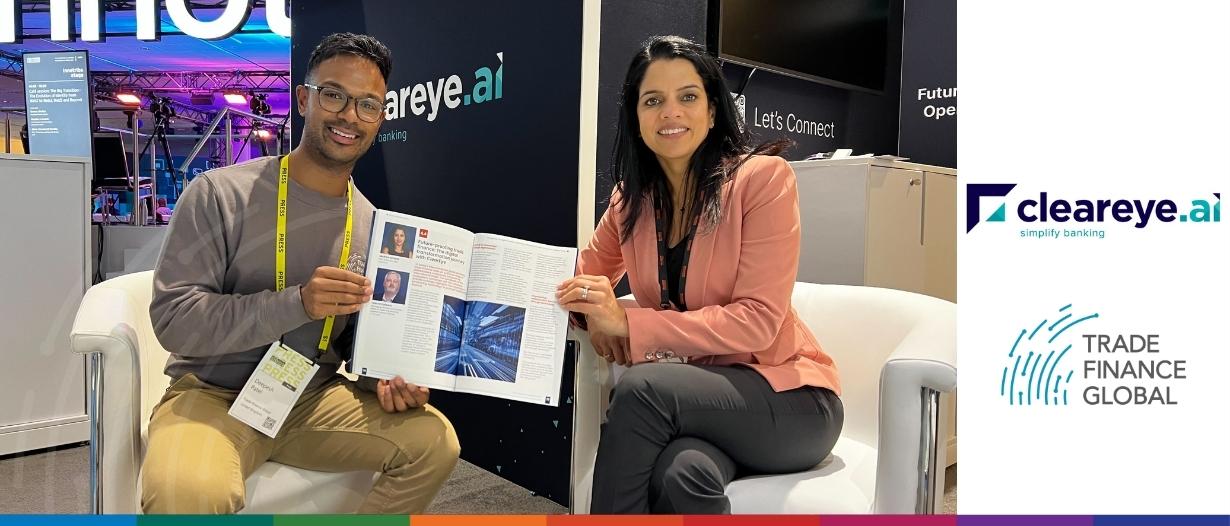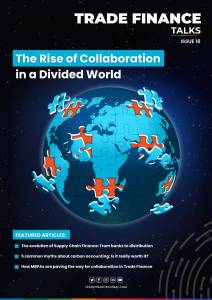Transitioning from documents to pixels, from cash to virtual payment gateways, and from local markets to international ones, the sweeping transformation of global trade into the digital world is redesigning the trade finance ecosystem. The alliance between ClearEye and J.P. Morgan represents the metamorphosis of the future of trade finance digitisation.
As the industry anticipates the upcoming Sibos 2023, themed ‘Collaborative finance in a fragmented world,’ TFG’s Deepesh Patel sat down with Mariya George, CEO & Co-Founder of ClearEye, and Tom Fitzgerald, J.P. Morgan’s Managing Director and Global Head of Trade and Working Capital Product Delivery.
Gaining an advantage through digitalisation
The journey of the trade finance industry towards digital transformation has encountered a distinct lack of momentum. With insolvencies of various fintech companies making headlines and the rapidly evolving regulatory frameworks influenced by current geopolitical events, navigating the digital landscape has proven to be a consistent challenge for the industry.
Recognising the need for transformative change, ClearEye and J.P. Morgan have joined forces with a revolutionary vision for the industry: to future-proof trade finance operations. George said, “It all starts with the back-office operations. There are a lot of challenges in today’s back-office operations, including the constantly changing regulatory challenges and needs, as well as the rising costs.”
George offered more information on ClearEye’s flagship platform, ClearTrade, and its robust capabilities, “ClearTrade focuses on three components: Digitisation, compliance/trade-based money laundering automation, and doc-exam operations automation.’’
Reinforcing the value of integrating ClearTrade and how the alliance bolsters J.P. Morgan’s trade finance objectives, Fitzgerald said, “Our internal business case around using this platform incorporates uplifting our compliance capabilities, reducing operational costs, and getting leverage through a partner relationship versus purely relying on in-house IT resources.”
Empowering collaborative finance through technology
In today’s interconnected global economy, trade finance relies on a diverse range of stakeholders, collectively empowering international trade. The complexity of this ecosystem, combined with the numerous entities involved, highlights the importance of embracing technology to promote collaborative finance.

Echoing ClearEye’s vision for technology-driven collaboration, George noted, “I don’t think there’s a better way to bring the world together than through technology.”
But ClearTrade’s capabilities extend beyond transaction processing.
“It’s a platform that can bring together the compliance team, the operations team to access all these external data sets that are required to do all the compliance checks,’’ she elaborated.
Furthermore, consolidating compliance and trade finance operations into a single automated solution is a remarkable step towards addressing one of the most notable challenges facing trade finance operations – fragmentation.
From exporters initiating transactions to banks handling cross-border exchanges, trade finance processes entail substantial lead times, typically lasting for days. ClearTrade can significantly expedite these processes. “With technology advancements,’’ George pointed out, “the lead times of trade finance processes can be reduced from days to hours. That’s a significant change.’’
The platform’s ability to automate labour-intensive manual checking processes including trade-based money laundering (TBML) verifications, holds the potential to revolutionise the pace and efficiency of trade finance operations.
Additionally, the alliance has successfully addressed one of the most persistent conundrums in the digital transformation of trade finance: how to adopt technology while maintaining trust in the financial industry.
This alliance demonstrates that striking a balance between the two is undoubtedly achievable. Despite the innovative nature of the collaboration, J.P. Morgan’s core principles of vendor evaluation and risk management have been integral to the alliance.
“The relationships might have a slightly different contractual structure, but at the end of the day, you’re relying on a third party that needs to protect our business, our clients, and our data. The concerns, the rules, and the risks that go into a fintech alliance are no different than a traditional vendor,” Fitzgerald underscored.
Supercharging efficiency: Single platform, multiple features

Starting in the domain of unstructured data processing, ClearTrade has evolved over the years into a breakthrough solution for trade finance operations and compliance Highlighting the platform’s capabilities, George put forth the several key features it offers:
- Automated noun extraction: ClearTrade automates noun extraction, a process that simplifies the identification of sanctioned entities and contributes to potential efficiency gains of 50% to 70%.
- Comprehensive compliance checks: With compliance as a priority, ClearTrade integrates data sets from multiple sources, enabling comprehensive checks such as vessel and container tracking, Bill of Lading validation, and the identification of military and dual-use goods.
- Dynamic rules engine: The platform’s dynamic rules engine offers users the flexibility to define and adjust rules, adapting to evolving regulations and requirements.
- Modular design: Its modular design allows financial institutions to tailor their adoption, starting with digitisation and compliance before expanding to include document examination.
- Full auditability: Another powerful feature is the system’s full auditability, ensuring transparency and accountability for every transaction and user action.
From a regulatory perspective, the platform’s ability to determine high-risk transactions by dissecting numerous variables offers a robust digital product for regulatory compliance automation.
According to Fitzgerald, “The ClearTrade platform can be configured to consider many daa elements that you see in current G7 trade sanctions, such as Russian oil price caps.’’
Forging ahead: ClearEye’s vision for the future
Digitising trade finance presents an unprecedented opportunity to reshape the industry, making it more efficient, inclusive, and sustainable. Following on their pioneering role in the digitisation of trade finance operations, ClearEye’s future holds multiple opportunities to scale. George affirmed, “We want to go deep and really solve the trade finance operations problem. There are different product types and other areas that we want to dive into. That’s our immediate focus area.’’
With a solid foundation in digitising trade finance operations, the strategic alliance between J.P. Morgan & ClearEye is set to inspire and future-proof the industry.
Subject to Client consent, J.P. Morgan Chase Bank, N.A. and any of its affiliates or branches (the Bank) may disclose to Cleareye.ai information necessary to facilitate an introduction, which information may include business contact (i.e., name and email address). The Client is responsible to ensure that all legal rights necessary, including those under applicable data protection laws, to provide the Bank with such information have been established. The Bank holds a convertible note and a warrant from Cleareye.ai and may receive an equity interest in the future. The Bank may profit from the Client’s use of any products and/or services provided by Cleareye.ai and the Bank is not endorsing Cleareye products and/or services nor does it advise on the suitability of these services for the Client’s needs. The Client shall make an independent determination as to the selection of products and/or services provided by Cleareye.ai. The Bank shall not be liable to the Client for any loss or liability suffered by the Client from its use of Cleareye.ai products and/or services.

















































